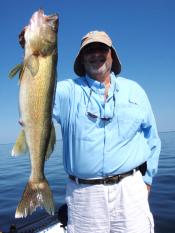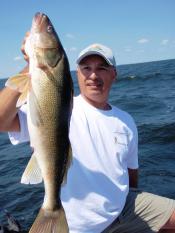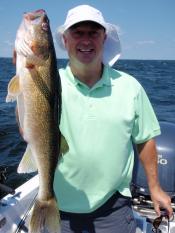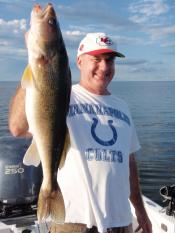 The open basin bite is in full swing and many suspended walleyes are falling victim to deep diving crankbaits. Over the past week, I was able to get out three times and each time out there were some subtle differences in what the walleyes wanted.
The open basin bite is in full swing and many suspended walleyes are falling victim to deep diving crankbaits. Over the past week, I was able to get out three times and each time out there were some subtle differences in what the walleyes wanted.
Since my last report, I’ve received numerous PMs and emails asking me some very good questions. Many of you asked “what is open basin trolling and where is it”? Open basin trolling is just another way of saying open water trolling. It’s when you are targeting suspended walleyes that are not relating to any type of structure. The reason the walleyes are out there is because they are feeding on baitfish – primarily tullibees in the case of Mille Lacs. The way to target these fish is to troll with deep diving crankbaits that mimic a tullibee profile behind planerboards and/or leadcore line. The way to find these suspended walleyes is to spend time scouting motoring up and down every half mile or so and looking for suspended arcs/baitfish on your sonar.
 Another question is how much line do I need to put out with my leadcore set up? As I already stated in my last report, I typically use longer leaders, 30 -50 feet. The way to calculate your depth is to first determine the depth curve for your crankbait with your leader length. Let’s say we marked some walleyes at 28 feet and we want to place our crankbait at 25 feet. The first thing we need to do is determine the depth curve for our leader (in this example we will use a 30 foot leader). Let’s say the crankbait that you tied on dives 10 feet when trolling with 30 feet of line (your leader). The difference that we need to make up is 15 feet of depth. Typically, leadcore line sinks about 5 feet per color (30 feet of line per color) when trolled at 2.0 mph. It doesn’t matter what lb. test leadcore line you are using because it will sink about the same because the lead inside the nylon sheath is the same. So in our example, in order for us to make up the difference (15 feet of depth), we need to let out 3 colors or 60 feet of leadcore line. The total amount of line we put out should say 110 feet on our line counter reel in order to achieve that desired 25 foot depth.
Another question is how much line do I need to put out with my leadcore set up? As I already stated in my last report, I typically use longer leaders, 30 -50 feet. The way to calculate your depth is to first determine the depth curve for your crankbait with your leader length. Let’s say we marked some walleyes at 28 feet and we want to place our crankbait at 25 feet. The first thing we need to do is determine the depth curve for our leader (in this example we will use a 30 foot leader). Let’s say the crankbait that you tied on dives 10 feet when trolling with 30 feet of line (your leader). The difference that we need to make up is 15 feet of depth. Typically, leadcore line sinks about 5 feet per color (30 feet of line per color) when trolled at 2.0 mph. It doesn’t matter what lb. test leadcore line you are using because it will sink about the same because the lead inside the nylon sheath is the same. So in our example, in order for us to make up the difference (15 feet of depth), we need to let out 3 colors or 60 feet of leadcore line. The total amount of line we put out should say 110 feet on our line counter reel in order to achieve that desired 25 foot depth.
One thing I’ve noticed the last couple of times out is there‘s an algae bloom happening on Mille Lacs Lake and it’s certainly affecting the water clarity. When this happens, I start to think about which crankbaits will have the most contrast or which colors will stand out more in their surroundings or backgrounds. Because of the greenish looking color of the lake, I’m starting to use more crankbaits now that have a flash or chrome in their color scheme. Noticing this small difference can turn a good day into a great day. A couple of these colors I have not used all year and they are now producing for me. I’ve also been catching walleyes higher in the water column sometimes as high as 15 feet especially early in the morning or before sunset. Tullibees feed high in the water column at night and then during the day search for cooler water temps deep below. Pay attention to your sonar and don’t be afraid to move those crankbaits up high. I was catching a few walleyes trolling braid only 90 feet back.
 Another thing that is extremely important is to make sure your crankbaits are properly tuned and that your hooks are sharp. Certain crankbaits are finicky and sometimes they are out of tune right out of the box. The first thing I do is to look for any abnormalities such as bent hooks or if the hooks are hanging crooked off of the hook hangers. Simply use a needle nose pliers and adjust accordingly. The next thing I do is shake the crankbait if it’s equipped with rattles inside. The vibration your crankbait gives off is extremely important and I believe attracts these suspended walleyes before they actually see it. Once in awhile a walleye will smash a crankbait and it’s sharp teeth will leave a small puncture hole. This in turn fills up with water and ruins the rattle vibration. The next thing I do is I pull the crankbait through the water a couple of feet down and examine if it’s running straight. If it swims to one side or the other, simply take your needle nose pliers and slightly bend the line tie eye the opposite direction. It doesn’t take much so adjust a little at a time. Test it again until you are satisfied that it’s swimming straight. Take the time to do this each and every time you put out your crankbait. If it’s not tuned properly, odds are it will not catch fish.
Another thing that is extremely important is to make sure your crankbaits are properly tuned and that your hooks are sharp. Certain crankbaits are finicky and sometimes they are out of tune right out of the box. The first thing I do is to look for any abnormalities such as bent hooks or if the hooks are hanging crooked off of the hook hangers. Simply use a needle nose pliers and adjust accordingly. The next thing I do is shake the crankbait if it’s equipped with rattles inside. The vibration your crankbait gives off is extremely important and I believe attracts these suspended walleyes before they actually see it. Once in awhile a walleye will smash a crankbait and it’s sharp teeth will leave a small puncture hole. This in turn fills up with water and ruins the rattle vibration. The next thing I do is I pull the crankbait through the water a couple of feet down and examine if it’s running straight. If it swims to one side or the other, simply take your needle nose pliers and slightly bend the line tie eye the opposite direction. It doesn’t take much so adjust a little at a time. Test it again until you are satisfied that it’s swimming straight. Take the time to do this each and every time you put out your crankbait. If it’s not tuned properly, odds are it will not catch fish.
 Keep the PMs and emails coming! I sincerely enjoy helping others catch fish out there. However, I do need to remind everyone to handle these fish with care especially with the warmer water temps. Have your net, your pliers and your camera ready so that you can get that fish back in the water as soon as possible. I try to do this under 20 seconds and anybody that has fished with me knows that! When releasing that fish, hold it under it’s belly (not under it’s gill) and point it so that the water is flowing freely through it’s gill. Take your time and make sure that it swims away on it’s own and don’t release it prematurely.
Keep the PMs and emails coming! I sincerely enjoy helping others catch fish out there. However, I do need to remind everyone to handle these fish with care especially with the warmer water temps. Have your net, your pliers and your camera ready so that you can get that fish back in the water as soon as possible. I try to do this under 20 seconds and anybody that has fished with me knows that! When releasing that fish, hold it under it’s belly (not under it’s gill) and point it so that the water is flowing freely through it’s gill. Take your time and make sure that it swims away on it’s own and don’t release it prematurely.
A big thank you goes out to Randy Russell, John Berg, Dan Calderon and Joe Cavanaugh. It was great spending time with all of you on the water, sharing stories, grilling brats and catching a few eyes. Until next time – keep trollin! 
A few more pictures…
Some more…
Great job Brad! Nice read – Should be up with a buddy on Sunday to do some cranking!
good job puttin the smack down on them walleyes!! nice pics and keep em coming
Awesome report as usual Brad

It’s no surprise you are always on fish With the amount of time and hard work you put in

Great report Brad! I was able to finally get a leadcore bite dialed in for some eaters this past Saturday as well. Open basin trolling often results in nice fish within mille lacs protected 20-28 inch protected slot. If a person is looking for table fare walleyes I found moving onto structure will increase the odds for both walleyes and jumbo perch. Once again Brads detailed info about leadcore eliminates the guess work of where your lure is running, scouting before trolling is also important while paying close attention to your gps/graph. I never had faith in trolling leadcore, however once a program is dialed in the confidence goes way up!!
Brad,
Great read and report,
Awesome. thanks,
Jack